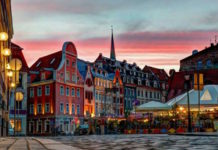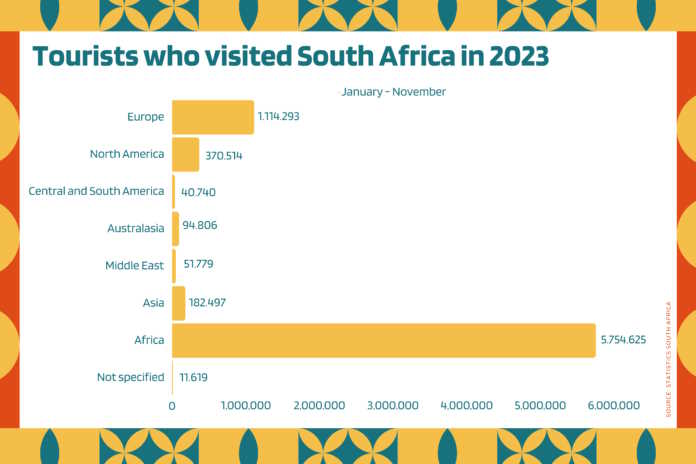South Africa was visited by almost 8 million international tourists in 2023
The figures show a 51.8% increase compared to the period between January and November 2022
South Africa is land rich in contrasts and diversity, emerging as an exceptional tourist destination where natural beauty, history, and a mix of cultures converge to offer a unique experience. This fusion not only enriches the lives of those who visit but also plays an essential role in the local economy, generating opportunities and sustaining communities across the country.
This varied demographic profile and different travel purposes contribute to enriching the tourist experience in South Africa, where diverse offerings are available to those seeking everything, from natural adventures to business opportunities and studies, perhaps even funded with personal loans tailored to their needs.
Based on the latest data from Statistics South Africa, the nation is showing sustained growth in the global travel industry, with the ambitious goal of surpassing pre-COVID figures and reaching over 10 million arrivals by March 2024. But how are the numbers looking?
With the year coming to an end, South Africa experienced a significant tourism rebound with 7,620,873 visitors, reflecting an impressive increase of 51.8% compared to the previous year. It is important to note the key contribution of African tourists, leading with 5,754,625 arrivals, marking an impressive growth of 53.4% compared to 2022.
Within the African region, the highest number of arrivals came from people from:
- Zimbabwe (1,898,136),
- Mozambique (1,212,559), and
- Lesotho (1,057,040)
The arrival of tourists from other regions was led by 1,114,293 from Europe, 370,514 from North America, 40,740 from Central and South America, 94,806 from Australasia, 51,779 from the Middle East, and 182,497 from Asia.
Additionally, the report from the agency provided more detailed information on visits received during November 2023, revealing a total flow of 2,582,023 travelers, considering arrivals, departures, and transits. Of this total, 647,542 were South African residents, and 1,934,481 were foreign travelers.
In this respect, this month South Africa received a total of 195,549 international tourists, with Europe leading the visits with 129,036 arrivals (66%). The top list is followed by North America with 33,022 (16.9%), Asia with 17,073 (8.7%), Australasia with 8,199 (4.2%), Central and South America with 5,450 (2.8%) and Middle East with 2,769 visits (1.4%).
Top source countries markets for South African tourism
Among the top 10 international tourism source countries, the United Kingdom leads the ranking with 32,561 visitors (16.7%) from that nationality. The list is completed with Germany, the United States, the Netherlands, France, India, Australia, Switzerland, Canada, and Belgium.
These countries were responsible for 73.8% of the total foreign tourists and, all of them reported an increase in the number of visits when compared to November 2022. In that sense, France shows as the country with the highest year-on-year growth (41.4%).
Zimbabwe (170,082), Mozambique (119,328), and Lesotho (83,982) led the SADC contribution, accounting for a solid 71.8%. Furthermore, tourists from other African countries outside the SADC totaled 14,647, equivalent to 2.0%.
Among them, Kenya (4,396), Ghana (2,987), and Nigeria (1,679) stood out, contributing to 61.9% of this group. It is worth mentioning that 1,159 tourists (0.2%) did not specify their country of residence.
“The rest of the African continent has always been vital to our tourism industry. It is clear that more reviews and revisions of immigration regulations and visa requirements are needed, as evidenced by the increase in arrivals from Kenya. As of January 1, 2023, Kenyans can travel to South Africa without a visa for a period of 90 days per year. I look forward to continuing to work with the rest of my colleagues in the government in this regard so that we can all reap mutual benefits from our collaboration initiatives.” according Tourism Minister Patricia de Lille (last year).
Means of Transport of Tourists
Regarding mobility, the report showed that the road emerged as the main means of transport for 1,694,176 travelers, representing 65.6% of the total of 2,582,0230. While a plane trip was the choice of 873,981 travelers, constituting 33.8%.
In the breakdown of South African resident arrivals, it is observed that 26.3% (267,437) opted for air transport, 73.3% (744,628) for the road, and less than 0.3% (3.519) by sea. Regarding departures, 43.1% (139,291) preferred the plane, 55.9% (180,750) the road, and less than 0.1% (3,222) by sea. In the case of transit travelers, all 482 used the plane.
In the case of foreign travelers, 23.6% (267,437) of them arrived by plane, 73.3% (744,628) by road, and 0.3% (3,519) by sea. Compared to the plane and the road, a minority of travelers, 0.2% (4,371), chose the sea to enter and exit South Africa.
Travel Purposes of Tourists
The demographic profile of foreign tourists highlights a significant distribution by ages and regions. Among visitors, individuals aged 25 to 34 represent a considerable proportion, evidencing the generational diversity of travelers.
In the age analysis, demographic diversity among tourists is evident: 25,614 (3.7%) were under 15 years old; 50,749 (7.4%) were between 15 and 24 years old; 171,220 (25.0%) ranged from 25 to 34 years old; 204,800 (29.9%) were in the range of 35 to 44 years old; 121,635 (17.8%) were between 45 and 54 years old; 67,054 (9.8%) belonged to the 55 to 64 years old range, and 43,088 (6.3%) were 65 years or older.
Regarding travel purposes, most African tourists, specifically 505,558 (96.4%), chose South Africa for vacationing. However, notable differences emerge between SADC tourists and those from “other” African countries in terms of their specific objectives.
96.5% of SADC tourists entered the country for vacation purposes, compared to 89.4% from “other” African countries. Specifically, 92.3% of tourists from East and Central Africa opted for vacations, followed by those from West Africa with 87.2%, and North Africa with 76.8%. In terms of business purposes, they represented 3.1% of SADC tourists, compared to 5.9% from “other” African countries.
In the educational field, students constituted 0.4% of SADC tourists, compared to 4.3% from “other” African countries. North Africa stood out with the highest proportion of tourists for study purposes, reaching 12.5%, followed by West Africa with 6.1%, and East and Central Africa with 2.2%.
[Compiled by Melisa Murialdo]
Information sources:
Department of Tourism, QuotesAdvisor.com, Statistics South Africa (Stats SA)














